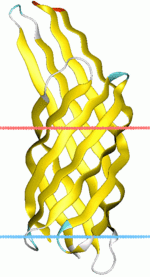- Virulence-related outer membrane protein family
-
Virulence-related OMP 
Identifiers Symbol Ail_Lom Pfam PF06316 InterPro IPR000758 PROSITE PDOC00582 SCOP 1qj9 OPM family 26 OPM protein 1qj8 Available protein structures: Pfam structures PDB RCSB PDB; PDBe PDBsum structure summary Virulence-related outer membrane proteins are expressed in Gram-negative bacteria and are essential to bacterial survival within macrophages and for eukaryotic cell invasion.
This family consists of several bacterial and phage Ail/Lom-like proteins. The Yersinia enterocolitica Ail protein is a known virulence factor. Proteins in this family are predicted to consist of eight transmembrane beta-sheets and four cell surface-exposed loops. It is thought that Ail directly promotes invasion and loop 2 contains an active site, perhaps a receptor-binding domain. The phage protein Lom is expressed during lysogeny, and encode host-cell envelope proteins. Lom is found in the bacterial outer membrane, and is homologous to virulence proteins of two other enterobacterial genera. It has been suggested that lysogeny may generally have a role in bacterial survival in animal hosts, and perhaps in pathogenesis.
Members of this group include:
- PagC, required by Salmonella typhimurium for survival in macrophages and for virulence in mice[1]
- Rck outer membrane protein of the S. typhimurium virulence plasmid[2]
- Ail, a product of the Yersinia enterocolitica chromosome capable of mediating bacterial adherence to and invasion of epithelial cell lines[3]
- OmpX from Escherichia coli that promotes adhesion to and entry into mammalian cells. It also has a role in the resistance against attack by the human complement system[4]
- a Bacteriophage lambda outer membrane protein, Lom[5]
The crystal structure of OmpX from E. coli reveals that OmpX consists of an eight-stranded antiparallel all-next-neighbour beta barrel[6]. The structure shows two girdles of aromatic amino acid residues and a ribbon of nonpolar residues that attach to the membrane interior. The core of the barrel consists of an extended hydrogen-bonding network of highly conserved residues. OmpX thus resembles an inverse micelle. The OmpX structure shows that the membrane-spanning part of the protein is much better conserved than the extracellular loops. Moreover, these loops form a protruding beta sheet, the edge of which presumably binds to external proteins. It is suggested that this type of binding promotes cell adhesion and invasion and helps defend against the complement system. Although OmpX has the same beta-sheet topology as the structurally related outer membrane protein A (OmpA) IPR000498, their barrels differ with respect to the shear numbers and internal hydrogen-bonding networks.
References
- ^ Miller SI (1991). "PhoP/PhoQ: macrophage-specific modulators of Salmonella virulence?". Mol. Microbiol. 5 (9): 2073–2078. doi:10.1111/j.1365-2958.1991.tb02135.x. PMID 1766380.
- ^ Cirillo DM, Heffernan EJ, Wu L, Harwood J, Fierer J, Guiney DG (1996). "Identification of a domain in Rck, a product of the Salmonella typhimurium virulence plasmid, required for both serum resistance and cell invasion". Infect. Immun. 64 (6): 2019–2023. PMC 174031. PMID 8675302. http://www.pubmedcentral.nih.gov/articlerender.fcgi?tool=pmcentrez&artid=174031.
- ^ Miller VL, Bliska JB, Falkow S (1990). "Nucleotide sequence of the Yersinia enterocolitica ail gene and characterization of the Ail protein product". J. Bacteriol. 172 (2): 1062–1069. PMC 208537. PMID 1688838. http://www.pubmedcentral.nih.gov/articlerender.fcgi?tool=pmcentrez&artid=208537.
- ^ Tommassen J, Stoorvogel J, van Bussel MJ, van de Klundert JA (1991). "Molecular characterization of an Enterobacter cloacae outer membrane protein (OmpX)". J. Bacteriol. 173 (1): 156–160. PMC 207169. PMID 1987115. http://www.pubmedcentral.nih.gov/articlerender.fcgi?tool=pmcentrez&artid=207169.
- ^ Pulkkinen WS, Miller SI (1991). "A Salmonella typhimurium virulence protein is similar to a Yersinia enterocolitica invasion protein and a bacteriophage lambda outer membrane protein". J. Bacteriol. 173 (1): 86–93. PMC 207160. PMID 1846140. http://www.pubmedcentral.nih.gov/articlerender.fcgi?tool=pmcentrez&artid=207160.
- ^ Schulz GE, Vogt J (1999). "The structure of the outer membrane protein OmpX from Escherichia coli reveals possible mechanisms of virulence". Structure 7 (10): 1301–1309. doi:10.1016/S0969-2126(00)80063-5. PMID 10545325.
Further reading
- Identification of regions of Ail required for the invasion and serum resistance phenotypes. Miller VL, Beer KB, Heusipp G, Young BM, Wachtel MR; Mol Microbiol 2001;41:1053-1062. PubMed
- A bacterial virulence determinant encoded by lysogenic coliphage lambda. Barondess JJ, Beckwith J; Nature 1990;346:871-874. PubMed

This membrane protein-related article is a stub. You can help Wikipedia by expanding it.
